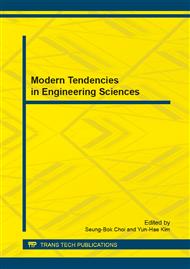[1]
A. E. S. Pellegrini, K. Schindler, and L.J.V. Gool, You'll never walk alone: Modeling social behavior for multi-target tracking, in in Proc. International Conference on Computer Vision (ICCV), 2009, Kyoto, Japan, 2009, pp.261-268.
DOI: 10.1109/iccv.2009.5459260
Google Scholar
[2]
A. Yilmaz, O. Javed, and M. Shah, Object tracking: A survey, in Acm Computing Surveys (CSUR) vol. 38, ed, 2006, p.13.
DOI: 10.1145/1177352.1177355
Google Scholar
[3]
C. a. S. Harris, M. , A Combined Corner and Edge Detector, presented at the Proceedings of the 4th Alvey Vision Conference, (1988).
Google Scholar
[4]
K. Mikolajczyk and C. Schmid, An Affine Invariant Interest Point Detector, presented at the Proceedings of the 7th European Conference on Computer Vision-Part I, (2002).
DOI: 10.1007/3-540-47969-4_9
Google Scholar
[5]
D. Lowe, Distinctive Image Features from Scale-Invariant Keypoints, International Journal of Computer Vision, vol. 60, pp.91-110, 2004/11/01 (2004).
DOI: 10.1023/b:visi.0000029664.99615.94
Google Scholar
[6]
V. Caselles, R. Kimmel, and G. Sapiro, Geodesic active contours, in Computer Vision, 1995. Proceedings., Fifth International Conference on, 1995, pp.694-699.
DOI: 10.1109/iccv.1995.466871
Google Scholar
[7]
D. Comaniciu and P. Meer, Mean shift analysis and applications, in Computer Vision, 1999. The Proceedings of the Seventh IEEE International Conference on, 1999, pp.1197-1203 vol. 2.
DOI: 10.1109/iccv.1999.790416
Google Scholar
[8]
J. Shi and J. Malik, Normalized cuts and image segmentation, Pattern Analysis and Machine Intelligence, IEEE Transactions on, vol. 22, pp.888-905, (2000).
DOI: 10.1109/34.868688
Google Scholar
[9]
C. Stauffer and W. E. L. Grimson, Learning patterns of activity using real-time tracking, Pattern Analysis and Machine Intelligence, IEEE Transactions on, vol. 22, pp.747-757, (2000).
DOI: 10.1109/34.868677
Google Scholar
[10]
N. M. Oliver, B. Rosario, and A. P. Pentland, A Bayesian computer vision system for modeling human interactions, Pattern Analysis and Machine Intelligence, IEEE Transactions on, vol. 22, pp.831-843, (2000).
DOI: 10.1109/34.868684
Google Scholar
[11]
A. Monnet, A. Mittal, N. Paragios, and V. Ramesh, Background modeling and subtraction of dynamic scenes, in Computer Vision, 2003. Proceedings. Ninth IEEE International Conference on, 2003, pp.1305-1312 vol. 2.
DOI: 10.1109/iccv.2003.1238641
Google Scholar
[12]
C. P. Papageorgiou, M. Oren, and T. Poggio, A general framework for object detection, in Computer Vision, 1998. Sixth International Conference on, 1998, pp.555-562.
DOI: 10.1109/iccv.1998.710772
Google Scholar
[13]
H. A. Rowley, S. Baluja, and T. Kanade, Neural network-based face detection, Pattern Analysis and Machine Intelligence, IEEE Transactions on, vol. 20, pp.23-38, (1998).
DOI: 10.1109/34.655647
Google Scholar
[14]
P. Viola, M. J. Jones, and D. Snow, Detecting pedestrians using patterns of motion and appearance, in Computer Vision, 2003. Proceedings. Ninth IEEE International Conference on, 2003, pp.734-741 vol. 2.
DOI: 10.1109/iccv.2003.1238422
Google Scholar
[15]
R. E. Kalman, A new approach to linear filtering and prediction problems, Journal of basic Engineering, vol. 82, pp.35-45, (1960).
DOI: 10.1115/1.3662552
Google Scholar


